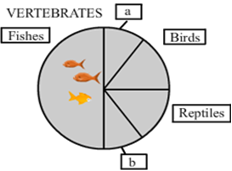 Long Answer Type
Long Answer Type Short Answer Type
Short Answer TypeIdentify 'a' and 'b' in the figure given below representing proportionate number of major vertebrate taxa.

Explain Darwinian theory of evolution with the help of one suitable example. State the two key concept of the theory.
Darwinian theory of Evolution
According to Darwin, evolution took place by natural selection.
The number of life forms depends upon their life span and their ability to multiply.
Another aspect of natural selection is the survival of the fittest where nature selects the individuals, which are most fit to adapt to their environment.
An example of such a selection is the antibiotic resistance in bacteria. When a bacterial population was grown on an agar plate containing antibiotic penicillin, the colonies that were sensitive to penicillin died, whereas one or few bacterial colonies that were resistant to penicillin survived. This is because these bacteria had undergone chance mutation, which resulted in the evolution of a gene that made them resistant to penicillin drug. Hence, the resistant bacteria multiplied quickly as compared to the non-resistant (sensitive) bacteria, thereby increasing their number. Hence, the advantage of an individual over the other helps in the struggle for existence.
Darwin also observed that variations are inheritable and the species fit to survive the most leaves more offsprings. Hence, the population’s characteristics change, giving rise to the evolution of new life forms.
The two key concepts of the theory are:
(1) Branching descent: According to this concept, various species have come into existence from a common ancestor.
(2) Natural selection: According to this concept, nature selects the individuals, which are most fit to adapt to their environment.
State a reason for the increased population of dark coloured moths coinciding with the loss of lichens (on tree barks) during industrialization period in England.
Identify the examples of convergent evolution from the following:
(i) Flippers of penguins and dolphins
(ii) Eyes of octopus and mammals
(iii) Vertebrate brainsWith the help of any two suitable examples explain the effect of anthropogenic actions on organic evolution.
Write the similarity between the wing of a butterfly and the wing of a bat. What do you infer from the above with reference to evolution?
 Long Answer Type
Long Answer Type